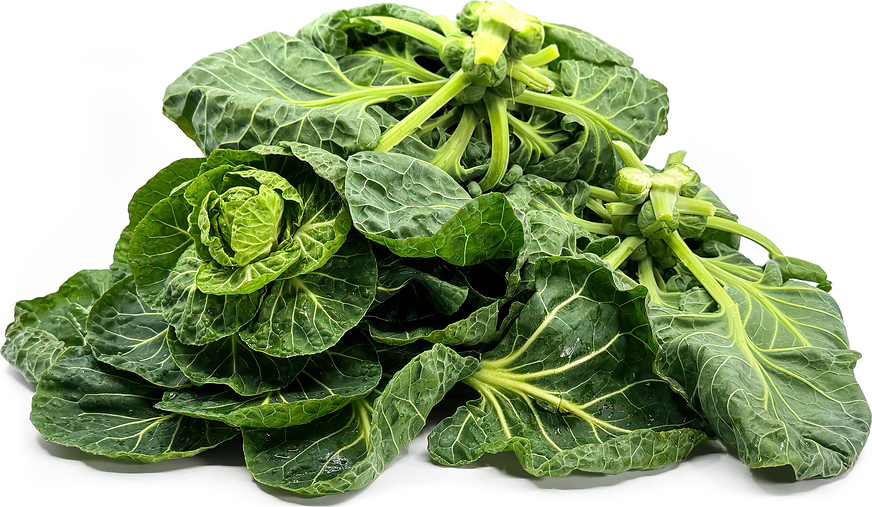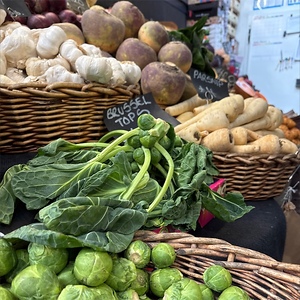


Brussels Sprouts Stem Tops
Estimated Inventory, lb : 0
Description/Taste
Brussels Sprouts Stem tops vary in size, depending on their maturity when cut from the plant. Each top is generally comprised of a loose rosette of overlapping, branching leaves. The base of the tops occasionally features small sprouts connected to the stalk, and the leaves have pale green and dark green hues. The leaves are broad, pliable, and deeply veined, creating a crinkled, textured nature. The leaves slightly curve when wrapped around others and flatten as they grow in size. Brussels Sprouts Stem tops are crisp, crunchy, and chewy when raw, becoming soft and tender with a silky, almost buttery feel once cooked. Raw greens emit a fresh, vegetal aroma. The stem tops are edible raw or cooked and known for their sweet, subtly bitter, green taste. Brussels Sprouts Stem tops have a similar flavor to the sprouts but notably lack sulfur undertones, creating a more palatable, milder taste.
Seasons/Availability
Brussels Sprouts Stem tops are available in the early fall through winter.
Current Facts
Brussels Sprouts Stem tops, botanically classified as Brassica oleracea, are the leafed crowns of the plant belonging to the Brassicaceae family. The stem tops form at the end of the upright stalks, which can grow anywhere from 60 to 90 centimeters in height. The entire Brussels Sprout plant is edible and is mainly known for its tightly packed sprouts, also known as auxiliary buds. Historically, Brussels Sprouts Stem tops are a lesser-known portion of the plant that was discarded, used as livestock feed, or consumed by the grower. As consumer preferences and desires changed in the modern era, focusing on more sustainable lifestyles, this encouraged farmers to begin selling stem tops in local markets as a culinary ingredient. Stem tops are sometimes marketed under the names Brussels Sprout Crowns, Brussels Sprout Tops, and Brussels Tops. Brussels Sprouts Stem tops are seasonal and only available in limited quantities for a short period each year. The stem tops have become positioned as a delicacy, and consumers value the tops for their milder, sweeter flavor, versatility, and fast-cooking times. Brussels Sprouts Stem tops are challenging to find and are primarily sold in their growing regions worldwide. Commercially, the stem tops are seen in Europe and are slowly expanding in notoriety to North America.
Nutritional Value
Brussels Sprouts Stem tops are a source of vitamins C, B, and K to strengthen the immune system, aid in faster wound healing, and contribute to energy production in the body. The stem tops also provide fiber to regulate the digestive tract, potassium to balance fluid levels within the body, and calcium to support bones and teeth. Other nutrients include iron to develop the protein hemoglobin for oxygen transport through the bloodstream, manganese to assist the body with metabolism, and folate to produce red blood cells.
Applications
Brussels Sprouts Stem tops have a mild, green, subtly sweet, and faintly bitter taste suited for raw and cooked preparations. Each top will vary in use based on size. Larger tops will need to be sliced or broken down into smaller pieces, while smaller stalks can be halved or cooked whole. The tops can be shredded and tossed into salads and slaws, or the leaves can be torn into larger pieces and layered into sandwiches. Intact leaves are sometimes used as a wrap. Try blending stem tops into sauces like pesto or smoothies in place of spinach or kale. In addition to raw preparations, stem tops are popularly cooked and can be used in recipes as a cabbage or winter green substitute. Brussels Sprouts Stem tops require less cooking time than other varieties like collard greens and develop a soft and tender consistency. The leaves are incorporated into egg-based dishes like quiche, omelets, and frittatas or cooked into gratins and casseroles. Stem tops can also be simmered into soups, curries, and stews, mixed into noodle and rice dishes, or stir-fried with mixed greens. Stem tops are versatile and can be steamed, sautéed, fried, boiled, or gently wilted. In England, stem tops are occasionally added to bubble and squeak, a dish traditionally made from meat, vegetables, and potato leftovers of other meals. The greens are folded into mashed potatoes and eaten with a choice of meat. Brussels Sprouts Stem tops pair well with herbs such as sage, rosemary, thyme, dill, mint, and oregano, nuts including sesame, chestnuts, hazelnuts, and almonds, and meats like poultry, beef, and pork. Unwashed stem tops have a short shelf life and should be used relatively soon after purchase for the best quality and flavor. The tops will also keep for 3 to 4 days when stored in the refrigerator’s crisper drawer.
Ethnic/Cultural Info
Brussels Sprouts Stem tops are typically removed from the plants during cultivation to allow the auxiliary buds, also known as the sprouts, to develop. This process is known as topping and is conducted to increase the size and yield of the buds. During the early stages of growth, stem tops are meant to protect the developing sprouts forming beneath the leaves. When the sprouts have reached 1 to 2 centimeters in diameter, the stem tops are removed to encourage the plant to put its energy into developing larger sprouts. Typically, topping must be done at a precise time, as removing the leaves too early can stunt growth, while removing them too late may cause the sprouts to remain small. This routine process created a lot of waste as the tops were not an original portion of the plant used for culinary purposes. Instead of discarding the leafy tops or using them solely as animal feed, growers began selling them as a rare, secondary crop for culinary purposes. The tops became a success, and growers shifted their focus to providing multiple portions of the plant as edible ingredients through local markets to create increased sources of revenue.
Geography/History
Brussels sprouts are descendants of wild cabbage-like plants native to regions within the Eastern Mediterranean, Asia Minor, and the Middle East. Wild forms have been naturally present since ancient times, and civilizations throughout the Mediterranean later selected plants with specific traits for domestication and cultivation, creating early Brussels sprout types. Over time, Brussels sprouts spread throughout Europe and Asia as a culinary crop. The species was noted in records in Ancient Greece and Rome and eventually spread to northern and western Europe. In the 13th century, early Brussels sprouts were introduced and planted in Brussels, Belgium. By the 16th century, the cold-hardy plants expanded in popularity across Belgium and Europe, increasing production to a larger commercial scale. Brussels sprouts also became a widespread home garden crop in the 1830s and 40s in England and were carried to the New World through French settlers in the early 19th century. Brussels Sprouts Stem tops have been present since the species’ creation and are a secondary crop to the tiny buds. The stem tops became more prevalent in fresh markets worldwide as growers began participating in the zero-waste movement in the late 20th and early 21st centuries. Brussels Sprouts Stem tops quickly became a seasonal delicacy in European markets, and the tops’ use expanded on a small scale worldwide as a mild, versatile culinary ingredient. Today, Brussels Sprouts Stems tops are still a relatively seasonal and rare item, found through select local retailers, farmers’ markets, or directly through growers worldwide. The Brussels Sprouts Stem tops featured in the photograph above were sourced through Borough Market in London, England.









